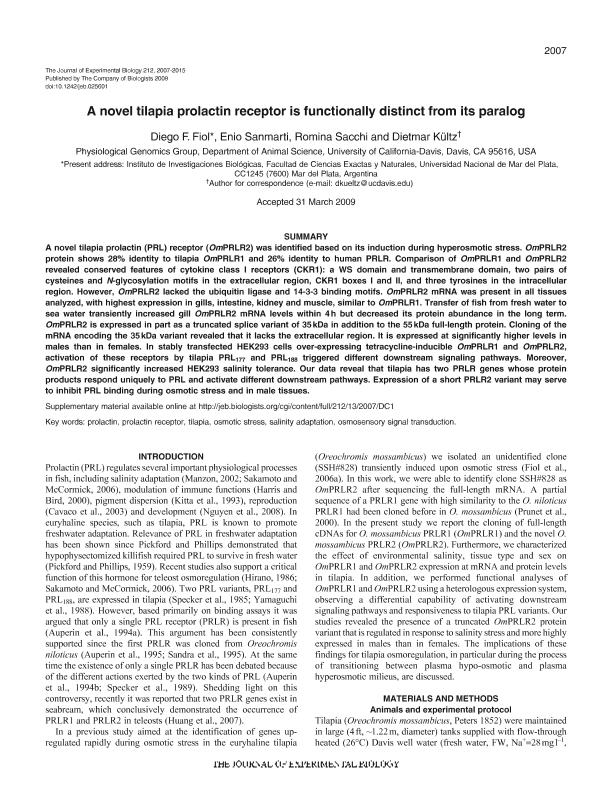Mostrar el registro sencillo del ítem
dc.contributor.author
Fiol, Diego Fernando

dc.contributor.author
Sanmarti, Enio
dc.contributor.author
Sacchi, Romina
dc.contributor.author
Kultz, Dietmar
dc.date.available
2020-05-14T19:12:01Z
dc.date.issued
2009-06
dc.identifier.citation
Fiol, Diego Fernando; Sanmarti, Enio; Sacchi, Romina; Kultz, Dietmar; A novel tilapia prolactin receptor is functionally distinct from its paralog; Company of Biologists; Journal of Experimental Biology; 212; 13; 6-2009; 2007-2015
dc.identifier.issn
0022-0949
dc.identifier.uri
http://hdl.handle.net/11336/105145
dc.description.abstract
A novel tilapia prolactin (PRL) receptor (OmPRLR2) was identified based on its induction during hyperosmotic stress. OmPRLR2 protein shows 28% identity to tilapia OmPRLR1 and 26% identity to human PRLR. Comparison of OmPRLR1 and OmPRLR2 revealed conserved features of cytokine class I receptors (CKR1): a WS domain and transmembrane domain, two pairs of cysteines and N-glycosylation motifs in the extracellular region, CKR1 boxes I and II, and three tyrosines in the intracellular region. However, OmPRLR2 lacked the ubiquitin ligase and 14-3-3 binding motifs. OmPRLR2 mRNA was present in all tissues analyzed, with highest expression in gills, intestine, kidney and muscle, similar to OmPRLR1. Transfer of fish from fresh water to sea water transiently increased gill OmPRLR2 mRNA levels within 4h but decreased its protein abundance in the long term. OmPRLR2 is expressed in part as a truncated splice variant of 35kDa in addition to the 55kDa full-length protein. Cloning of the mRNA encoding the 35kDa variant revealed that it lacks the extracellular region. It is expressed at significantly higher levels in males than in females. In stably transfected HEK293 cells over-expressing tetracycline-inducible OmPRLR1 and OmPRLR2, activation of these receptors by tilapia PRL177 and PRL188 triggered different downstream signaling pathways. Moreover, OmPRLR2 significantly increased HEK293 salinity tolerance. Our data reveal that tilapia has two PRLR genes whose protein products respond uniquely to PRL and activate different downstream pathways. Expression of a short PRLR2 variant may serve to inhibit PRL binding during osmotic stress and in male tissues.
dc.format
application/pdf
dc.language.iso
eng
dc.publisher
Company of Biologists

dc.rights
info:eu-repo/semantics/openAccess
dc.rights.uri
https://creativecommons.org/licenses/by-nc-sa/2.5/ar/
dc.subject
osmotic stress
dc.subject
prolactin receptor
dc.subject
tilapia
dc.subject.classification
Bioquímica y Biología Molecular

dc.subject.classification
Ciencias Biológicas

dc.subject.classification
CIENCIAS NATURALES Y EXACTAS

dc.title
A novel tilapia prolactin receptor is functionally distinct from its paralog
dc.type
info:eu-repo/semantics/article
dc.type
info:ar-repo/semantics/artículo
dc.type
info:eu-repo/semantics/publishedVersion
dc.date.updated
2020-05-05T16:11:16Z
dc.journal.volume
212
dc.journal.number
13
dc.journal.pagination
2007-2015
dc.journal.pais
Reino Unido

dc.journal.ciudad
Cambridge
dc.description.fil
Fil: Fiol, Diego Fernando. University of California at Davis; Estados Unidos. Consejo Nacional de Investigaciones Científicas y Técnicas. Centro Científico Tecnológico Conicet - Mar del Plata. Instituto de Investigaciones Biológicas. Universidad Nacional de Mar del Plata. Facultad de Ciencias Exactas y Naturales. Instituto de Investigaciones Biológicas; Argentina
dc.description.fil
Fil: Sanmarti, Enio. University of California at Davis; Estados Unidos
dc.description.fil
Fil: Sacchi, Romina. University of California at Davis; Estados Unidos
dc.description.fil
Fil: Kultz, Dietmar. University of California at Davis; Estados Unidos
dc.journal.title
Journal of Experimental Biology

dc.relation.alternativeid
info:eu-repo/semantics/altIdentifier/doi/http://dx.doi.org/10.1242/jeb.025601
dc.relation.alternativeid
info:eu-repo/semantics/altIdentifier/url/https://jeb.biologists.org/content/212/13/2007.long
Archivos asociados
